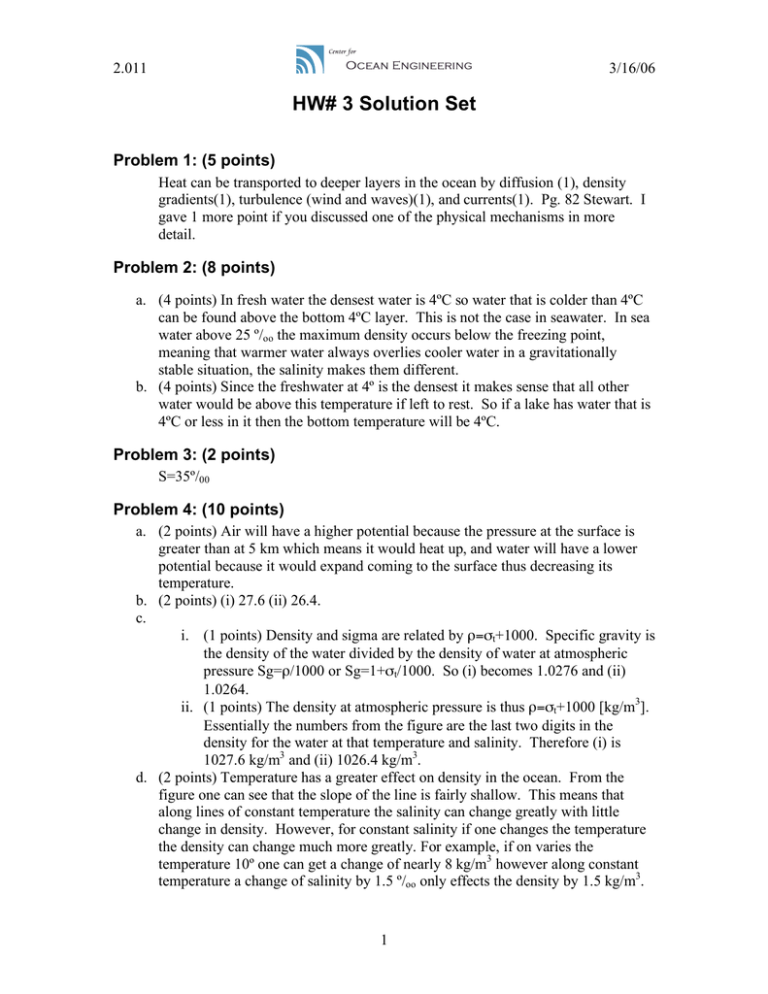HW# 3 Solution Set Problem 1: (5 points)
advertisement

2.011 3/16/06 HW# 3 Solution Set Problem 1: (5 points) Heat can be transported to deeper layers in the ocean by diffusion (1), density gradients(1), turbulence (wind and waves)(1), and currents(1). Pg. 82 Stewart. I gave 1 more point if you discussed one of the physical mechanisms in more detail. Problem 2: (8 points) a. (4 points) In fresh water the densest water is 4ºC so water that is colder than 4ºC can be found above the bottom 4ºC layer. This is not the case in seawater. In sea water above 25 º/oo the maximum density occurs below the freezing point, meaning that warmer water always overlies cooler water in a gravitationally stable situation, the salinity makes them different. b. (4 points) Since the freshwater at 4º is the densest it makes sense that all other water would be above this temperature if left to rest. So if a lake has water that is 4ºC or less in it then the bottom temperature will be 4ºC. Problem 3: (2 points) S=35º/00 Problem 4: (10 points) a. (2 points) Air will have a higher potential because the pressure at the surface is greater than at 5 km which means it would heat up, and water will have a lower potential because it would expand coming to the surface thus decreasing its temperature. b. (2 points) (i) 27.6 (ii) 26.4. c. i. (1 points) Density and sigma are related by ρ=σt+1000. Specific gravity is the density of the water divided by the density of water at atmospheric pressure Sg=ρ/1000 or Sg=1+σt/1000. So (i) becomes 1.0276 and (ii) 1.0264. ii. (1 points) The density at atmospheric pressure is thus ρ=σt+1000 [kg/m3]. Essentially the numbers from the figure are the last two digits in the density for the water at that temperature and salinity. Therefore (i) is 1027.6 kg/m3 and (ii) 1026.4 kg/m3. d. (2 points) Temperature has a greater effect on density in the ocean. From the figure one can see that the slope of the line is fairly shallow. This means that along lines of constant temperature the salinity can change greatly with little change in density. However, for constant salinity if one changes the temperature the density can change much more greatly. For example, if on varies the temperature 10º one can get a change of nearly 8 kg/m3 however along constant temperature a change of salinity by 1.5 º/oo only effects the density by 1.5 kg/m3. 1 2.011 3/16/06 Surely a greater change in salinity may show a greater change in density, however salinity in the ocean varies by as little as 2º/oo and so according to this figure temperature has a greater effect on density than salinity. Problem 5: (10 points) a. (2 points) The surface waters are much warmer than the deep ocean for latitudes from 50ºS to 50º N. Beyond that the temperature gradient is fairly small. For latitudes from 50ºS to 20ºN the water is saltiest near the surface then decreases to ~1000 m then slightly increases until the bottom. Above the 60º latitudes the water salinity is nearly constant with respect to depth. The area between 20ºN and 60 ºN is saltier at the surface but has a small change from surface to bottom. In general there is a steep gradient near the surface for both salinity and temperature, then the gradient becomes much more gradual after ~1000m. b. (2 points) A corresponds to profile 1 and B to profile 2. c. (2 points) A corresponds to profile 1 and B to profile 2. d. (2 points) The haloclines and thermoclines seem to be similar in shape and depth except for the salinity minimums. These occur around 700 m in general whereas the minimum temperature is always below 3000 – 4000 m. e. (2 points) B shows greater decrease in salinity with depth. Problem 6: (4 points) a. (2 points) (i) matches with a, (ii) matches with b. (2 points) Figure (a) shows an increase in temperature below 4000m thus this must be in situ temperature (description i), whereas figure (b) must correspond with description (ii) b/c it shows cooler water near the bottom, and is thus the potential temperature part (corrected for adiabatic compression). The potential temperature profiles and cross sections are more realistic b/c of these corrections so description (ii) is correct. Problem 7: (8 points) a. (2 points) Light propagates in ocean at 2.25E8 m/s2 and sound at 1.5E3 m/s2, which means light travels 150,000 times faster than sound in water. b. (2 points) The difference in refractive indexes between air and water cause some of the rays of the sun to be reflected from the surface of the water. Whenever two interfaces meet and light passes between them, they will always reflect light if they do not have the same refractive index (albedo). For the ocean 2% of the light is reflected from a light sourse directly above the surface. c. (2 points) Light attenuation is very high in the ocean. This means that the light is absorbed rapidly and that it doesn’t reach very deep before the ocean appears without light. Because the particles in the water absorb the energy so well the water near the surface is much higher temperature than deeper down. Light attenuates to a depth of about 200 m. http://oceanexplorer.noaa.gov/explorations/04deepscope/background/deep light/deeplight.html 2 2.011 3/16/06 d. (2 points) Light is attenuated by particles in the water. Many waters appear blue, which can mean unproductive water or water that does not produce a lot of microscopic life. Phytoplankton and algae absorb different wavelengths of light and often change the color of the water from above due to this absorption. When this happens it can often mean the waters are more productive or full of microorganisms and appear blue green. It is also common to see brown waters near river inlets and deltas. This is due to the absorption from the sediment in the water. 3






